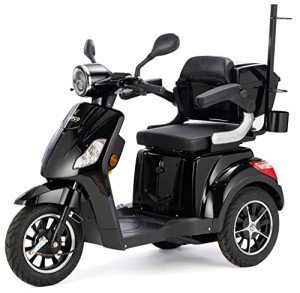A Comprehensive Guide to Buying a Mobility Scooter
Mobility scooters have ended up being an essential tool for numerous people looking to enhance their self-reliance and mobility. With a vast selection of designs and functions readily available, choosing the right mobility scooter can be daunting. This short article provides an informative guide to assist consumers browse their choices, examine their needs, and make an informed purchase.
Comprehending Mobility Scooters
Mobility scooters are electric cars designed for individuals who experience mobility challenges. They are especially helpful for elders, those with impairments, or individuals recovering from injuries. Mobility scooters can vary extensively in regards to design, functions, and rates.
Kinds Of Mobility Scooters
Before embarking on a purchase, it's important to understand the different types of mobility scooters offered:
Three-Wheel Scooters:
- Generally more maneuverable in tight areas
- Lightweight and portable
- Suitable for indoor use
Four-Wheel Scooters:
- Offer greater stability and balance
- Appropriate for outdoor usage over various terrains
- Generally have a longer battery life
Foldable/Portable Scooters:
- Designed to be easily transported and saved
- Can frequently fit in the trunk of a cars and truck
- Ideal for those who take a trip frequently
Sturdy Scooters:
- Built to accommodate bigger people
- Often featured more robust features for outdoor usage
- Normally geared up with larger batteries for prolonged variety
Aspects to Consider When Buying a Mobility Scooter
1. Weight Capacity
Choose a mobility scooter that can support the user's weight. The majority of scooters have a weight limit ranging from 250 to 500 pounds. It is essential to make sure that the scooter can accommodate the user comfortably.
2. Range and Battery Life
The variety is how far the mobility scooter can take a trip on a single charge. Common varieties vary in between 10 to 30 miles. Think about the user's daily activities and choose a scooter with a suitable variety.
3. Scooter Dimensions
Think about the size of the scooter, including its weight and dimensions. A more compact scooter may be perfect for narrow corridors and tight spaces, while bigger models provide extra stability and convenience.
4. Terrain Capability
Evaluate where the scooter will primarily be utilized. If the user prepares to take a trip primarily on pavement, a lightweight model may be sufficient. Nevertheless, if the user needs to pass through gravel or unequal surfaces, think about a four-wheel scooter developed for off-road use.
Top Features to Look For
Convenience
- Adjustable Seats: Look for scooters with cushioned and height-adjustable seats to ensure convenience during travel.
- Armrests: These boost safety and assistance while browsing.
Safety and Visibility
- Headlights and Taillights: Essential for nighttime usage.
- Turn Signals and Reflectors: Improve presence and security while on the roadway.
User-Friendly Controls
- Joystick or Drive Controls: These should be intuitive and easy to manipulate.
- Easy-to-Read Displays: A control panel that reveals battery life, speed, and range can boost the user experience.
Extra Features
- Storage Compartments: These use included convenience for carrying individual items while on the go.
- Weather condition Protection: Consider models with rain covers or windshields if used in variable weather.
Cost Considerations
When budgeting for a mobility scooter, rates can range anywhere from ₤ 500 to over ₤ 5,000 depending on the model, features, and brand. Additional expenses may include:
- Extended Warranty: Protects against flaws and can conserve cash in the long run.
- Accessories: Optional features, such as updated seats, lights, or storage solutions.
| Feature | Cost Range |
|---|---|
| Basic Models | ₤ 500 - ₤ 1,500 |
| Mid-Range Models | ₤ 1,500 - ₤ 3,000 |
| High-End Models | ₤ 3,000 - ₤ 5,000 |
Funding Options
Many merchants use financing plans, and some regional federal government efforts might supply grants or assistance for those in need. Examine possible monetary help with community resources or mobility service organizations.
FAQs about Buying a Mobility Scooter
What is the distinction between a mobility scooter and a wheelchair?
Mobility scooters are motorized and allow users to navigate individually, while wheelchairs may need physical assistance or manual operation.
How do I keep a mobility scooter?
Routine maintenance involves inspecting battery life, cleaning up the scooter, and checking tires and brakes. Constantly describe the user handbook for particular guidelines.
Can mobility scooters be utilized inside your home?
Yes, numerous designs are created for both indoor and outdoor use. Nevertheless, three-wheel scooters tend to be much better fit for indoor navigation due to their tighter turning radius.
Are mobility scooters covered by insurance coverage?
Some insurance plans cover a part of the costs for mobility scooters if they are deemed clinically necessary. Contact your company for specific information.
How quick can a mobility scooter go?
Most mobility scooters have a maximum speed varying from 4 to 8 mph. Nevertheless, new mobility scooters may differ depending on regional regulations.
Purchasing a mobility scooter can significantly improve one's self-reliance and lifestyle. By understanding the types, functions, and expenses connected with mobility scooters, potential purchasers can make knowledgeable decisions that suit their needs and preferences. Customization and comprehensive research study are key to making sure complete satisfaction with this crucial financial investment.

